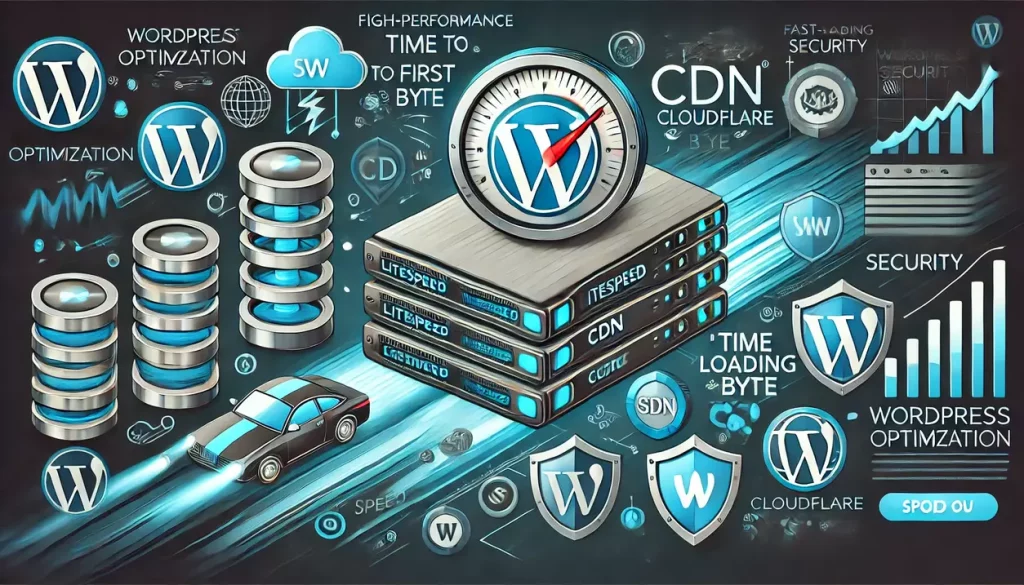WordPress, the most popular content management system (CMS) in the world, powers over 40% of websites globally. However, as your website grows in complexity and traffic, optimizing it for speed and security becomes essential.
By the end of this guide, you’ll be equipped with actionable insights to make your WordPress site faster, more secure, and scalable.
Understanding Website Performance: Key Metrics
Before diving into optimization techniques, it’s essential to understand the performance metrics that affect user experience and search engine rankings.
Time to First Byte (TTFB)
TTFB measures how long it takes the user’s browser to receive the first byte of data from your server after making an HTTP request.
A low TTFB (preferably under 200ms) indicates a fast server response time, which directly affects how quickly the rest of your page loads. Improving TTFB can often be achieved through web server optimization, using a CDN, and enabling caching.
Page Load Time
Page Load Time is the total time it takes for a webpage to fully load all of its resources.
While TTFB influences the start of this process, optimizations like image compression, lazy loading, and resource minification affect the overall time.
First Contentful Paint (FCP) & Largest Contentful Paint (LCP)
These are vital metrics for Core Web Vitals, a Google ranking factor.
FCP measures the time it takes to load the first visible content (like text or images), while LCP focuses on the largest element on the page. Keeping both under 2.5 seconds is ideal for user experience and SEO.
Optimizing WordPress Speed
Use LiteSpeed Web Server
LiteSpeed is an enterprise-grade web server optimized for speed, performance, and security. It is often preferred over Apache or Nginx for WordPress due to its better support for dynamic content and server-side caching. Here’s why:
- Built-in Caching: LiteSpeed’s built-in LSCache plugin optimizes your WordPress website with minimal effort. It can cache dynamic content and even handle WooCommerce stores efficiently by bypassing cache for sensitive pages like checkout.
- HTTP/3 Support: LiteSpeed supports the latest HTTP/3 protocol, improving page load times and performance over poor network conditions.
- QUIC Protocol: LiteSpeed uses QUIC to deliver faster content delivery over slow or congested networks, significantly reducing TTFB.
To set up LiteSpeed on your WordPress server, you can either install the LiteSpeed Web Server or use a hosting provider that offers LiteSpeed hosting. Then, install and configure the LiteSpeed Cache Plugin.
# Install LiteSpeed Web Server
sudo apt-get update
sudo apt-get install openlitespeed
In your WordPress dashboard, install the LSCache plugin from the plugin repository, and configure the caching options, image optimization, and minification settings.
Enable Server-Side Caching
Caching is critical for reducing TTFB and improving site speed. With server-side caching, frequently accessed data is stored in memory, significantly reducing the time to generate a page. LiteSpeed’s LSCache plugin provides an excellent solution for full-page caching, object caching, and browser caching.
To configure server-side caching:
- Install the LiteSpeed Cache Plugin.
- Enable caching for dynamic content and HTML pages.
- Configure Object Cache for WooCommerce or other heavy sites using Redis or Memcached.
# Enable Redis Caching for Object Cache
sudo apt install redis-server
In LSCache settings, navigate to Cache > Object and enable Redis.
Image Optimization
Images are one of the largest contributors to slow loading times. Optimizing images can drastically reduce page size and improve load times.
- Compress Images: Use tools like Imagify or Smush to compress images without losing quality.
- Lazy Loading: Deferring offscreen images by enabling lazy loading ensures only images visible on the screen are loaded initially.
Minifying CSS, JS, and HTML
Minifying involves removing unnecessary spaces and comments in your code, reducing file sizes and improving load speeds. You can enable automatic minification through the LiteSpeed Cache plugin.
In LSCache:
- Navigate to Page Optimization.
- Enable CSS Minify, JS Minify, and HTML Minify options.
This process not only makes your site faster but also reduces the number of HTTP requests, optimizing resource loading.
Database Optimization
As your WordPress site grows, so does your database. Optimizing the database regularly will prevent bloat and improve response times.
- Remove Post Revisions: Post revisions can clog the database. You can limit or remove them by adding this line to your
wp-config.phpfile:
define( 'WP_POST_REVISIONS', 3 );
- Optimize the Database: Plugins like WP-Optimize or Advanced Database Cleaner help to clean up unused database tables, transients, and post revisions.
# Manually optimize the database
sudo mysqlcheck -o wordpress_db
Content Delivery Networks (CDN) and Cloudflare Integration
A Content Delivery Network (CDN) stores copies of your website on multiple servers across different geographic locations. When a user accesses your site, the CDN serves content from the server closest to them, reducing latency and TTFB.
Cloudflare is a popular CDN that offers both free and premium services. It also comes with built-in security features like DDoS protection, WAF, and SSL support. Cloudflare optimizes content delivery through:
- Cache Everything mode, where static content is cached globally.
- Image Optimization with Polish and Mirage, reducing image size.
- Auto-Minification of CSS, JavaScript, and HTML files.
To integrate Cloudflare:
- Create a Cloudflare account.
- Change your domain’s DNS to point to Cloudflare’s nameservers.
- In the Cloudflare dashboard, enable features like caching, Auto-Minify, and Brotli compression.
# Install Cloudflare CLI for Server Management
curl -sL https://deb.cloudflare.com/pubkey.gpg | sudo apt-key add -
sudo apt-get install cloudflare-warp
Improving WordPress Security
Regular Software Updates
Keeping WordPress core, plugins, and themes updated is the most basic yet essential security step. Vulnerabilities are frequently discovered, and patches are released to address them.
# Update WordPress Core
wp core update
Web Application Firewall (WAF)
A WAF filters and monitors HTTP requests and protects your website from malicious attacks like SQL injection and XSS attacks. Cloudflare’s WAF or security plugins like Wordfence can be effective solutions.
Security Headers
Adding security headers like X-Content-Type-Options and Strict-Transport-Security can help mitigate attacks by providing browser-side protections.
# Add Security Headers in Apache
Header set X-Content-Type-Options "nosniff"
Header set Strict-Transport-Security "max-age=31536000; includeSubDomains"
SSL/TLS Implementation
SSL ensures that data transferred between your users and the server is encrypted. Use Let’s Encrypt to generate a free SSL certificate and configure HTTPS across your site.
# Install Let's Encrypt SSL
sudo certbot --apache
WordPress Hardening Techniques
- Disable XML-RPC: It’s a common attack vector. You can disable it by adding the following to your
.htaccessfile:
<Files xmlrpc.php>
Order Allow,Deny
Deny from all
</Files>
- File Permissions: Ensure proper file permissions. Set directories to 755 and files to 644 to prevent unauthorized access.
sudo find /var/www/wordpress/ -type d -exec chmod 755 {} \;
sudo find /var/www/wordpress/ -type f -exec chmod 644 {} \;
The Importance of Monitoring and Regular Audits
No optimization or security measure is complete without ongoing monitoring.
Use tools like New Relic or GTMetrix to monitor performance metrics and get real-time alerts for any downtime or security threats. Regular audits and updates ensure that your WordPress site remains fast, secure, and scalable.
Conclusion
Optimizing your WordPress site for speed and security is not just about better user experience but also about improving SEO rankings and minimizing security risks.
Whether it’s configuring LiteSpeed with caching mechanisms, leveraging a CDN like Cloudflare, or tightening security through regular updates and WAF, all of these measures combined will create a performant and secure WordPress site that can handle growing traffic and threats.





